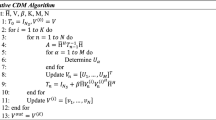Abstract
The complex channel fading statistics and large antenna array employed in massive multiple input and multiple outputs (MIMO) for uplink and downlink transmission. The large channel array makes it challenging to recognize the most accurate data from a composite signal at the receiver. This is one of the crucial problems that needs to be solved in 5G and next-generation communication. In order to address this tricky problem in contemporary wireless systems, a new investigation is being done on the development of optimal detectors employing bio-inspired algorithms. With bio-inspired evolutionary algorithms, an effective uplink data detection model is put forth in this article. For MIMO uplink transmission, the performance of data detectors is compared using numerical techniques, compressed sensing, state space adaptive filtering, and bio-inspired algorithms. The analysis using bio-inspired evolutionary algorithms, including Reptile Search algorithm (RSA), Dandelion optimization (DO), Harris Hawks optimization (HHO), Runge Kutta optimization (RUN), Zebra optimization algorithm (ZOA), and Beluga whale optimization (BWO), provides a clear picture for choosing the best detector for modern wireless applications. Performance metrics like bit error rate (BER) and mean square error (MSE) are used to analyze and compare the simulation outcomes. It has been determined after careful investigation that RSA-based data detectors work better than other alternatives and can be effectively used by wireless receivers to retrieve signals reliably.













Similar content being viewed by others
Data availability
Not applicable.
References
Jung-Chieh C (2017) A low complexity data detection algorithm for uplink multiuser massive MIMO systems. IEEE J Sel Areas Commun 35:1701–1714
Sayyed S, Patel A (2020) Low complexity signal detection for massive-MIMO systems. IEEE Wirel Commun Lett 9:1467–1470
Shahabuddin S, Markku J, Studer C (2017) ADMM-based infinity norm detection for large MU-MIMO: algorithm and VLSI architecture. IEEE international symposium on circuits and systems. pp 1–4
Tang C, Liu C, Yuan L, Xing Z (2017) Approximate iteration detection with iterative refinement in massive MIMO systems. IET Commun 11:1152–1157
Kazem I, Shaban A, Damen O (2022) Low-complexity detectors for uplink massive MIMO systems leveraging truncated polynomial expansion. IEEE Access 10:91610–91621
Silva GMF, Marinello Filho JC, Abrao T (2018) Sequential likelihood ascent search detector for massive MIMO systems. AEU Int J Electron Commun 96:30–39
Mojtaba A, Amir A (2021) An iterative detector based on sparse Bayesian error recovery for uplink large-scale MIMO systems. AEU Int J Electron Commun 138:1–8
Jing Z, Jun L, Zhongfeng W (2018) An improved Gauss–Seidel algorithm and its efficient architecture for massive MIMO systems. IEEE Trans Circuits Syst II Express Briefs 65:1194–1198
Liu L, Peng G, Wang P (2020) Energy- and area-efficient recursive-conjugate-gradient-based MMSE detector for massive MIMO systems. IEEE Trans Signal Process 68:573–588
Jia Z, Cheng W, Zhang H (2019) A partial learning-based detection scheme for massive MIMO. IEEE Wirel Commun Lett 8:1137–1140
Xiao L, Yang P, Xiao Y, Fan S, Renzo MD, Xiang W (2017) Efficient compressive sensing detectors for generalized spatial modulation systems. IEEE Trans Veh Technol 66:1284–1298
Song W, Wang W (2020) Compressive sensing based multiuser detector for massive MBM MIMO uplink. J Syst Eng Electron 31:19–27
Jung-Chieh C (2018) Manifold optimization approach for data detection in massive multiuser MIMO systems. IEEE Trans Veh Technol 67:3652–3657
Jung-Chieh C (2019) Computationally efficient data detection algorithm for massive MU-MIMO systems using PSK modulations. IEEE Commun Lett 23:983–986
Jianmin D, Hui S, Liu D, Yu H (2016) Square root cubature Kalman filter-Kalman filter algorithm for intelligent vehicle position estimate. ELSEVIER Procedia Eng 137:267–276
Juan C, Santos L, Ramon O, Daniel A, Leopoldo A (2021) The cubature Kalman filter revisited. ELSEVIER Autom 127:1–6
Heidari AA, Mirjalili S, Faris H, Aljarah I, Mafarja M, Chen H (2019) Harris hawks optimization: algorithm and applications. Future Gen Comput Syst 97:849–872
Hussien AG, Abualigah L, Zitar RA, Hashim FA (2022) Recent advances in Harris hawks optimization: a comparative study and applications. Electronics 11,1919:1–50
Kamboj VK, Nandi A, Bhadoria A, Sehgal S (2020) An intensify Harris hawks optimizer for numerical and engineering optimization problems. Appl Soft Comput 89:1–35
Tripathy BK, Maddikunta PKR, Pham QV, Gadekallu TR (2022) Harris hawk optimization: a survey on variants and applications. Comput Intell Neurosci Hindawi 2022:1–22
Zhong C, Gang L, Zeng M (2022) Beluga whale optimization: a novel nature-inspired metaheuristic algorithm. Knowl Based Syst 251:1–23
Mirjalili S, Lewis A (2016) The whale optimization algorithm. Adv Eng Softw 95:51–67
Eva T, Mohammad D, Pavel T (2022) Zebra optimization algorithm: a new bio-inspired optimization algorithm for solving optimization algorithm. IEEE Access 10:49445–49473
Zhao S, Zhang T, Ma S, Chen M (2022) Dandelion optimizer: a nature-inspired metaheuristic algorithm for engineering applications. Eng Appl Artif Intell 114:1–20
Ahmadianfar I, Heidari AA, Gandomi AH, Chu X, Chen H (2021) An efficient optimization algorithm based on Runge Kutta method. Expert Syst Appl 181:1–22
Devi RM, Manoharan P, Jangir P, Elkotb MA (2022) IRKO: an improved Runge–Kutta optimization algorithm for global optimization problems. Comput Mater Contin 70:4803–4827
Laith A, Abd EM, Putra S, Woo GZ, Gandomi AH (2022) Reptile search algorithm (RSA): a nature-inspired meta-heuristic optimizer. Expert Syst Appl 191:1–33
Sahoo M, Sahoo HK (2023) Performance analysis of 5 G wireless hybrid precoding using evolutionary algorithms. J Bionic Eng 20:2317–2330
Sahoo M, Sahoo H.K (2021) Multiuser Massive MIMO Channel Estimation and BER Analysis Using Convex Combination Based Algorithms. Wirel Personal Commun 123:3025–3049
Acknowledgements
For the successful completion of the research effort, the authors acknowledge the help of the Institute of Technical Education and Research, Siksha ’o’ Anusandhan, Jagamara, Bhubaneswar, and Veer Surendra Sai University of Technology, Burla, Sambalpur, India in terms of the E-library and Laboratory. Authors have taken some algorithms like HHO, and RUN for detector performance comparison as used in their recent publication for a completely different application on precoder design for wireless systems in Springer Bionic Engineering Journal and the same is cited in 28 of the reference section.
Funding
Not applicable.
Author information
Authors and Affiliations
Corresponding author
Ethics declarations
Conflict of interest
The authors have no competing interests to declare that are relevant to the content of this article.
Rights and permissions
Springer Nature or its licensor (e.g. a society or other partner) holds exclusive rights to this article under a publishing agreement with the author(s) or other rightsholder(s); author self-archiving of the accepted manuscript version of this article is solely governed by the terms of such publishing agreement and applicable law.
About this article
Cite this article
Sahoo, M., Sahoo, H.K. Optimal multiuser uplink data detection for 5G communication networks. Int. j. inf. tecnol. 16, 1407–1418 (2024). https://doi.org/10.1007/s41870-023-01691-z
Received:
Accepted:
Published:
Issue Date:
DOI: https://doi.org/10.1007/s41870-023-01691-z




